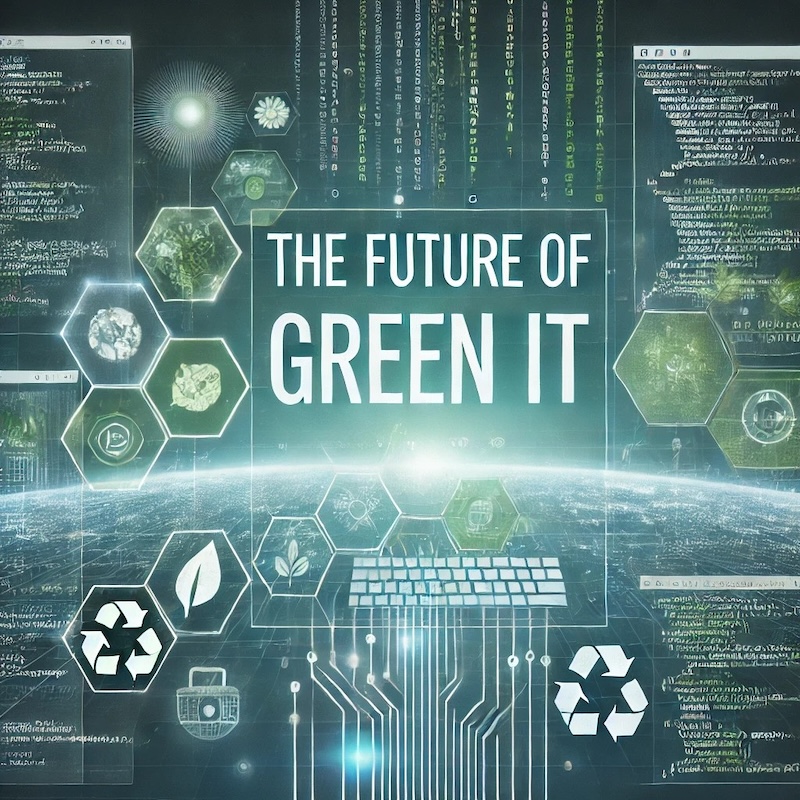An introduction to Green IT and the benefits of Green software
In this article
Summary
Green IT is more than just an environmental buzzword; it’s a strategic imperative for businesses looking to minimize their carbon footprint, comply with evolving regulations, and drive operational efficiency.
This article delves into the critical role software plays in the Green IT landscape, exploring how adopting sustainable software practices can significantly reduce energy consumption, mitigate regulatory risks, and enhance business outcomes. By implementing Green IT strategies, organizations can not only contribute to a more sustainable future but also gain a competitive edge through increased productivity, higher software quality, and improved employee satisfaction.

What is Green IT?
Let’s begin our introduction to Green IT by delving a little deeper into the definition.
Green IT—sometimes referred to by its synonyms, green computing or sustainable IT– aims to minimize the negative effects of IT operations on the environment.
Green IT is an umbrella term encompassing various practices to minimize the environmental impact of IT operations. In general, when looking up information on this topic, there is a lot of focus on the hardware and infrastructure side of things. However, the software itself has a bigger role to play than you may initially think.
That’s right, applications that transmit large volumes of data can consume substantial energy. Inefficient coding practices can further increase this consumption.
Here at Software Improvement Group (SIG), we’ve been writing on the impact of IT on the climate, and how to implement Green IT software development practices in practicable ways, since 2014. This article is written to create a useful introductory guide to Green IT for any software developers, CIOs, CTOs, CSOs, or other IT leaders keen to learn what it means for their business.
The carbon footprint of software
Today, data centers consume around 2% of the world’s entire electricity output, with this share predicted to grow to 8% by 2030. As a result, it is estimated that the combined IT and Communications industry will, by 2040, be responsible for 14% of our total global carbon emissions. The boom in Artificial Intelligence plays a significant role in this, too, in that the training of large AI models has been shown to require a doubling of computational power every 3.4 months on average.
With the world facing significant climate challenges due to climate change driven by industrial activities, these numbers are—to use a fitting term—simply unsustainable.
To facilitate the survival and continued growth of not only the IT industry, but the world itself, experts point to the growing importance of adopting Green IT practices in software development. Interestingly, however, sustainable IT and green software can deliver many more benefits to your business than just a reduced carbon footprint.

The rising need for green software practices
In a 2011 Elsevier article, computer scientists Stefan Naumann, Markus Dick, Eva Kern, and Timo Johann introduced The GREENSOFT model and identified the exponential need for green software development as directly linked to the exponential increase in demand for software and its resultant energy consumption.
The practices comprising Green IT have previously centered around the replacement of legacy hardware with more eco-friendly hardware, and the recycling of this hardware at the end of its lifecycle. However, to ‘green’ IT as a whole, means of making software and its development more sustainable are now being more seriously considered.
The importance and benefits of Green IT
Many of our readers will already understand the positive impacts of a greener IT industry on climate change and the future health of our environment.
However, we’ve identified four additional ways in which organizations can benefit from implementing Green IT practices.
1) Reducing the carbon footprint of software
As we touched upon earlier, the development of IT infrastructure is currently on a path of exponential growth, leading in turn to an exponential increase in the burden it places on the environment.

For example, researchers in 2019 discovered that the energy required to maintain the Bitcoin network alone consumes more energy than the entire nation of Switzerland. Similarly, it has been reported that training a single AI model can generate as much carbon as five ICE cars would in their lifetime.
Another example demonstrating software development’s high carbon footprint involves a study into the energy consumption of programming languages. A study by the team at Green Coding revisited a 2017 claim that coding with Python consumed 75x the energy that coding with C does. They discovered that in the seven years that had lapsed between the original claim and their own study, this figure had only slightly improved to around 61x the energy consumption of C.
At SIG, our research has established a clear causal link between writing more efficient source code and lower carbon emissions—demonstrating a mutually beneficial relationship between sustainability and software development.
Our preliminary results show a 17% average reduction (and even up to 90% in extreme cases) in a company’s energy consumption where Green IT practices are applied to the software development processes. These findings were presented by our CEO, Luc Brandts, during our recent SCOPE2024 IT leadership event.
2) Mitigating growing regulatory pressures
As national and international regulatory bodies push the transition of our current landscape toward a green economy, or Net Zero economy, the pressure on ICT companies to meet ‘green goals’ increases.
For example, in 2023 the pioneering Corporate Sustainability Reporting Directive (CSRD) came into force across the EU, requiring large enterprises and a broad range of SMEs to begin reporting on the environmental risks they face, as well as their impact on people and the environment, as of 2024.
The Securities and Exchange Commission (SEC) in the United States plans to improve and standardize climate-related disclosures made by public companies and in public offerings. Meanwhile, the UK has implemented the UK Sustainable Disclosure Regulation (SDR) to offer investors more thorough, consistent, and comparable sustainability information from issuers and investment managers.

Sustainability reporting and monitoring regulations will likely become more comprehensive over time and be adopted across the globe.
Adopting Green IT practices can help companies better comply with legislation like CSRD while preparing them for future compliance with policies that may be even more stringent.
3) Economic benefits
Perhaps one of the more surprising outcomes of Green IT is the degree to which it can economically benefit those organizations that employ it.
Sustainable IT does this in two ways: by first reducing your software development costs (such as reducing energy bills by 17-90%, as previously discussed), and secondly by increasing your potential ROI on software development.
Gartner refers to Green IT practices that both improve sustainability and your bottom line as “two-for-ones. For example, writing more efficient code during the development phase of the SDLC is a classic “two-for-one”, because it reduces the energy required to run that code while simultaneously reducing the cost of maintenance.

In addition to Green IT implementation resulting in lower operational costs, it can also help businesses increase their software ROI. Greater (and thus greener) efficiency in software development frees up resources from maintenance to be reinvested in more profitable areas of software development, such as innovation. More efficient software can also be scaled and adapted more readily, allowing organizations to meet sudden increases in demand for their products.
4) Higher productivity, quality, and employee retention
Implementing Green IT practices across your business can result in a variety of other indirect, often surprising benefits to the software development process and company structure. Let’s take a look:
- Making code more efficient—for the sake of reducing its carbon consumption post-development—also makes it much easier for engineers to work with, edit, manipulate, scale, and move in the future, thus improving their productivity. By having to spend less time on maintenance tasks, the development teams can instead focus their attention on innovation.
- When code is written more efficiently from the get-go, as encouraged by Software Quality Management best practices, for example, it typically leads to a higher-quality product.
- Employee satisfaction and retention rates can also be improved, indirectly, when Green IT practices are followed. An improvement in the sustainable efficiency of your SDLCs and a reduction in stressful maintenance can foster a happier workforce.

Green IT examples
Of course, we don’t expect our readers just to simply take our word for the effectiveness and importance of sustainable software development.
Below, we identify two real-world case studies in which Green IT practices were successfully implemented.
BitTorrent
BitTorrent, one of the internet’s most popular torrenting providers, was, until recently, using a legacy architecture that generated hugely unsustainable levels of carbon emissions. Under the legacy architecture in question, for a user to download a file from BitTorrent, all peer devices had to stay connected to the overlay network for the duration of the download, which typically took several hours.
BitTorrent’s operational model consumed large amounts of energy in return for relatively slow download speeds.
To address their sustainability problem, BitTorrent devised a new, green, proxy model. The proxy architecture devised by BitTorrent allowed a single peer device to act as a proxy while other peer devices were turned off during the download process. BitTorrent found that this one simple change reduced the energy consumption of their peers’ devices by up to 95%, massively reducing their carbon footprint. Even better, the new model also sped up download times by around 22%, delivering an improved service to their users.
Zoom
As anyone who lived through the 2020-22 Coronavirus pandemic will know, the video-conferencing software company Zoom has become something of a household name. Recently, an experimental case study into ‘greening’ Zoom made a bold discovery.
The authors of the study noticed that whenever an internet user clicked on a link to join a Zoom meeting, Zoom would automatically initiate a download of the desktop program to the user’s device. The authors postulated that this was an unnecessary functionality since most Zoom users would either already have the Zoom app installed or would happily proceed to join the meeting via their browser, instead.
The study calculated that removing the automatic download trigger from Zoom would save the company somewhere in the region of 13.7 tons of CO2 annually (equivalent to around 14x the CO2 emitted by a Berlin-New York passenger flight). Moreover, the study argued that these emissions could be saved without any impact on Zoom’s bottom line, UX, or UI, and without having to make any major software alterations.

The future of Green IT
Sustainable software development is no longer a lofty, moralistic idea, but a practical set of solutions businesses can implement at low cost, for high reward.
But where does Green IT, and more specifically green software development, go from here?
While we’re beginning to understand the need and benefits of developing green software, much more will need to be accomplished in the ICT sector before it can offset its carbon footprint.
Experts point to a few key areas of software development that may prove fundamental to the future of Green IT:
- The role of CIOs and CSOs: A McKinsey report on the future of Green IT emphasized the increasing importance of the role Chief Information Officers (CIOs) and Chief Sustainability Officers (CSOs) will play in the management of ICT companies.
- Moving to the Cloud: Cloud storage is also predicted to play an increasingly important part in the rollout of Green IT strategies, given the unsustainable energy consumption of large in-house data centers.
- AI as a catalyst for change: AI, though itself a high consumer of energy, is remarkably efficient at analyzing and processing vast datasets. For the future of Green IT, if treated with responsibility, AI can be a key player in optimizing software development efficiency, and in analyzing the energy consumption patterns of ICT businesses, allowing leaders to quickly and accurately identify areas of over-consumption and address this excess carbon output.
- Introduction of green measurement systems: Finally, it is understood that green software metrics will need to be introduced to effectively assess the sustainability of software development processes, and to encourage the adoption of Green IT.
Conclusion
We hope that this introduction to Green IT has provided you with a foundational understanding of the practice and its myriad benefits for software development efficiency and business growth. Over the coming weeks, we will be publishing a range of articles exploring aspects of Green IT covered here in even greater detail.
As we move toward an even more IT-intensive future, Green IT adoption will prove fundamental to your ability to keep costs down, reduce your carbon footprint, comply with international regulations, and meet your short- and long-term environmental goals.



